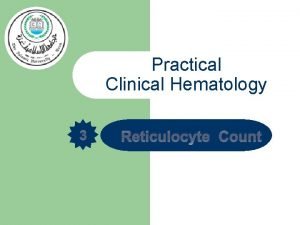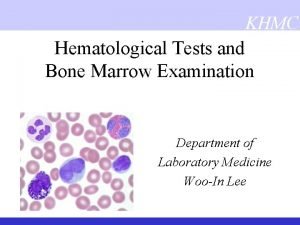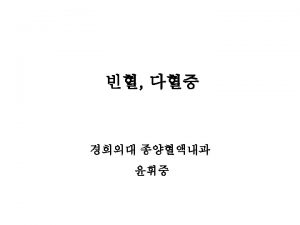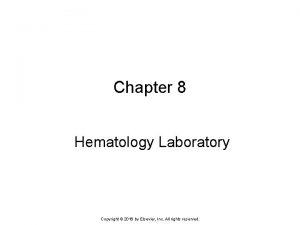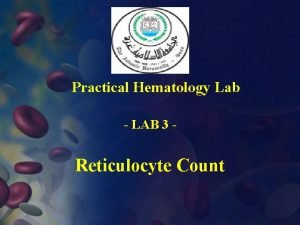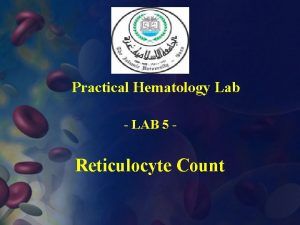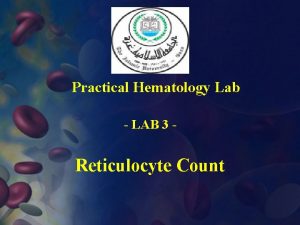Performing a Reticulocyte Count Reticulocytes A reticulocyte is










- Slides: 10

Performing a Reticulocyte Count

Reticulocytes • A reticulocyte is an immature RBC that still has remnants of RNA in the RBC’s cytoplasm. • A reticulocyte count gives the health care provider an idea of how many immature RBCs are in the patient’s peripheral blood. • This is only an estimate and is an indirect way of estimating the growth process of a person’s RBCs (erythropoiesis).

Reticulocytes • Red blood cells are produced in the bone marrow. • As they mature they loose their nucleus and move out into the peripheral blood circulation. • For the first 24 hours, while circulating they still contain the remnants of their RNA in their cytoplasm. • On a blood smear stained with Wright’s stain they appear larger and stain more bluish. • Stained with a supravital stain (new methylene blue or brilliant cresyl blue) will make the reticulocyte appear to have granules inside it. • Retics appear blue tinged with dark blue to purple granules or reticulum inside the RBC. • Retics are also larger than more mature RBCs. • Mature RBCs appear bluish green with no granules inside them.

Performing a Reticulocyte Count • The reticulocyte procedure is performed on capillary blood or venous blood collected in EDTA. • The reticulocyte count should be performed on blood within 4 hours of the collection time. • A small amount of well mixed blood is added to an equal amount of reticulocyte stain in a small vial. • The mixture is allowed to stand for 15 or so minutes depending on the type of stain used. • The mixture is then used to make a blood smear. • The smear should be allowed to air dry before the staining procedure begins.

Performing a Reticulocyte Count • There are two commonly used methods for counting reticulocytes. —Standard counting procedure —Miller Reticle procedure • Standard counting procedure ü Dry smear is examined under oil immersion. ü Total of 1, 000 RBCs are counted. ü Number of reticulocytes are recorded per 1, 000 RBCs. ü Retics are counted twice. ü Once as a retic and a second time as an RBC.

Performing a Reticulocyte Count • Miller Reticle Procedure ü Dry smear is examined under oil immersion. ü A eyepiece with a Miller reticle can be used. ü It is two squares. One large square with a smaller square in the corner. ü For each field of view the retics are counted in the whole large square (including the small). üAll RBCs lying within the small square counted including reticulocytes and that number is recorded as red cells. ü This is repeated until 100 to 200 RBCs are counted in the small squares.

Performing a Reticulocyte Count • A reticulocyte count is reported as the percentage of RBCs that are reticulocytes. • Each calculation depends on the counting procedure used. • Standard Calculating Procedure ü # of reticulocytes counted X 100 = % Retics Total # RBCs counted ü # of reticulocytes 1000 X 100 = % Retics

Performing a Reticulocyte Count • Miller Reticle Calculating Procedure • The formula is different than the standard because of the Miller reticle squares used. ü # of reticulocytes counted X 100 = % Retics Total # RBCs counted X 9

Reference Ranges • The reticulocyte percentage depends on age. • Newborns have a high reticulocyte count that decreases after 2 weeks of age. • In a healthy adult the retic count is usually stable. • About 1% of RBCs will stain as reticulocytes when using the supravital stains previously discussed. • Newborns 2. 5 -6. 5% • Adults 0. 5 -1. 5%

Reference Ranges • The increased reticulocyte percentage can be caused by…. . • Hemolytic anemias • Hemorrhage • Heavy smoking • Living at high altitudes • Treated folate, iron, B 12 deficiency • A decrease reticulocyte percentage can be caused by…. . • Aplastic anemia • Bone marrow failure • Untreated Vitamin B 12 deficiency and Iron deficiency



